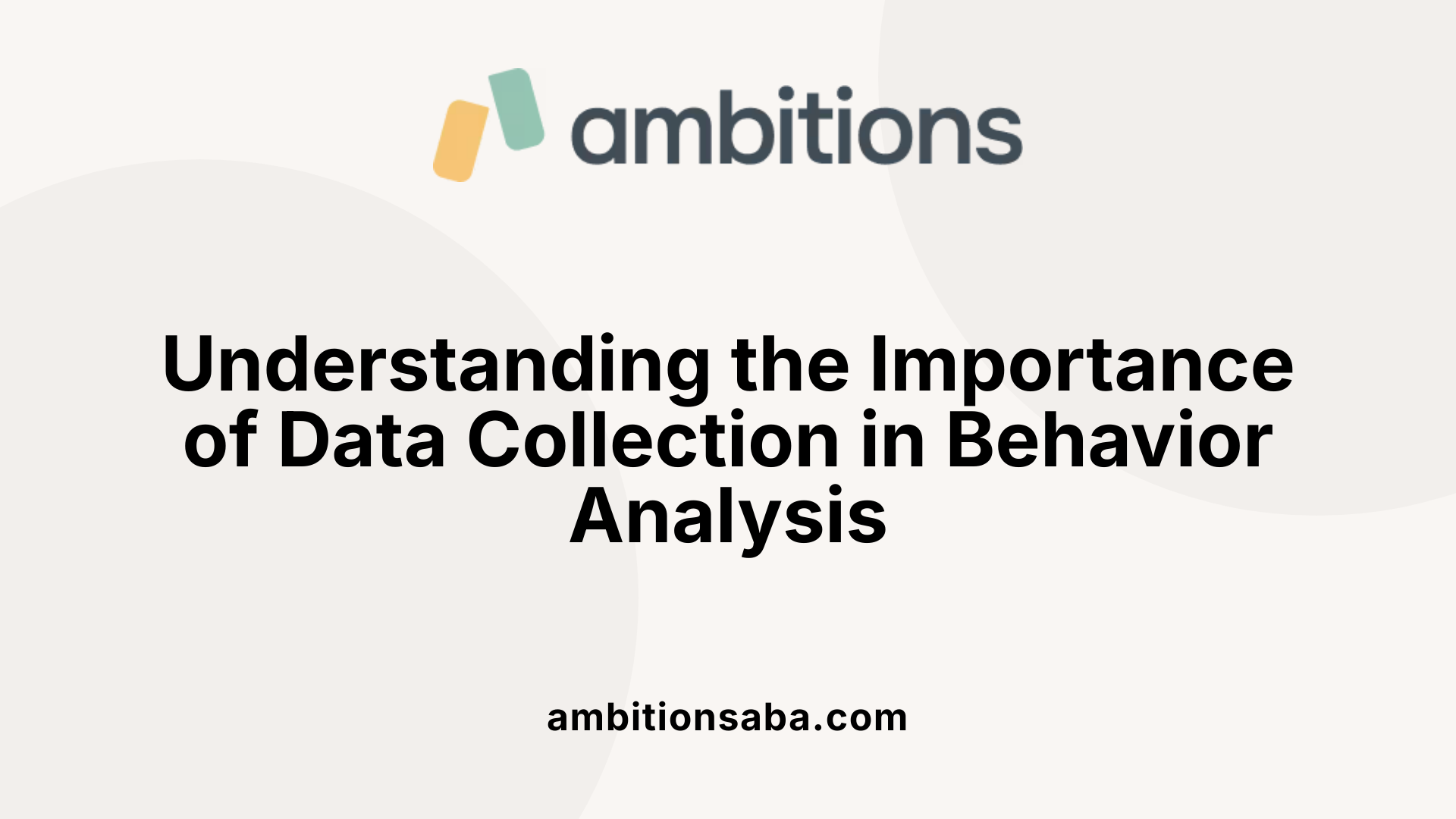Understanding Data Collection in ABA Therapy
Applied Behavior Analysis (ABA) therapy relies on evidence-based practices to support children with Autism Spectrum Disorder and other developmental challenges. At the heart of this approach lies data collection, a crucial component that influences treatment plans and determines therapy effectiveness. This article delves into the significance of data collection in ABA therapy, unpacking methodologies, benefits, and modern advancements that enhance therapeutic outcomes.
The Significance of Data Collection in Behavior Analysis

Why is data collection important in behavior analysis?
Data collection is crucial in behavior analysis as it empowers behavior analysts to make evidence-based clinical decisions. This process hinges on the integrity of the data gathered; accurate data collection leads to better understanding and assessment of a child's behavior, facilitating tailored interventions.
The ability to track a child's progress through various data types—such as frequency, duration, and ABC analysis—enables therapists to identify behavior triggers and gauge severity effectively. For instance, frequency recording helps in understanding how often a behavior occurs, while duration recording provides insights into sustained behaviors that may require intervention. The specificity of these methods aids in lightening the complexities involved in recognizing behavior patterns.
Additionally, data collection enhances communication between therapists, parents, and caregivers by providing a clear, objective view of progress and areas needing improvement. This clarity fosters teamwork in adapting therapy plans and increasing the overall effectiveness of interventions.
In summary, accurate data collection lays the groundwork for informed decision-making in behavior analysis, guiding both therapists and families toward successful outcomes in therapy.
Data Collection's Influence on ABA Therapy

How does data collection impact the effectiveness of ABA therapy?
Data collection is integral to the success of Applied Behavior Analysis (ABA) therapy. It enables therapists to accurately assess the effectiveness of interventions tailored for each client. By systematically recording behaviors, clinicians can understand progress, modification needs, and the overall impact of treatment strategies on a child’s development.
Registered Behavior Technicians (RBTs) hold a pivotal role in this process, as they are responsible for collecting data during therapy sessions. Their observations feed directly into the personalized treatment plans crafted by Board Certified Behavior Analysts (BCBAs).
Effective data collection not only enhances collaboration between therapists and families but also ensures that care is consistent and engagement is high. This collaborative approach strengthens the implementation of Behavior Intervention Plans (BIPs), allowing for a more unified strategy to tackle the child’s challenges.
Continuous monitoring through precise data ensures that therapists can swiftly adjust BIPs, which is crucial when addressing newly emerging behaviors. This adaptability is paramount in enhancing therapy outcomes for children with autism and developmental disabilities.
Ultimately, rigorous and systematic data-driven practices serve as the foundation for successful ABA therapy, fostering positive behavioral changes and improving family engagements. Regular assessments empower parents with insights into their child's progress, promoting active participation in the therapeutic journey.
Methodologies for Data Collection in ABA Therapy

What methodologies are used for data collection in ABA therapy?
ABA therapy employs diverse data collection methodologies geared towards enhancing the learning and developmental outcomes for individuals, especially those on the Autism Spectrum. The most common methods include:
| Methodology | Purpose | Insight Provided |
|---|---|---|
| Frequency/Event Recording | Measures how often a specific behavior occurs. | Helps in identifying behavioral patterns that require modification or reinforcement. |
| Duration Recording | Captures the length of time a behavior persists during an observation period. | Provides insights into persistent behaviors needing further intervention and monitoring. |
| Latency Recording | Measures the time it takes for an individual to respond after a given cue. | Indicates the effectiveness of cues or prompts used in interventions. |
| Time Sampling Recording | Collects data over specific intervals to assess behavior occurrence during those periods. | Useful in identifying trends at various times, helping clinicians to optimize scheduling and engagement. |
| Permanent Product Measurement | Evaluates the outcome of a behavior based on tangible results (e.g., completed assignments). | Enhances understanding of long-term skills acquisition and retention in a practical context. |
| ABC Data (Antecedent-Behavior-Consequence) | Captures the sequence of events to understand triggers and responses. | Fundamental for developing targeted interventions by linking behaviors to their contextual origins. |
These methodologies enable clinicians to monitor critical behaviors that need adjustment, assess intervention effectiveness, and adjust treatment plans accordingly. By analyzing the collected data, clinicians gain valuable insights into the progress of each client, which significantly influences their future therapy decisions.
Incorporating frameworks like the PEAK Relational Training System within ABA underscores the emphasis on sound data collection practices. By utilizing structured methods, behavior analysts can systematically support individuals with ASD in acquiring essential life skills.
Enhancing Data Collection Integrity in ABA

What are the challenges associated with DCI and how can they be addressed?
Data collection integrity (DCI) is paramount in Applied Behavior Analysis (ABA), influencing clinical decisions and therapeutic effectiveness. However, challenges persist in this area. A concerning 76% of behavior analysts report skepticism about the accuracy of the data collected. This widespread doubt raises important questions about the fidelity of the therapy provided.
Moreover, 85% of surveyed professionals noted that data collectors sometimes fail to complete collection tasks. This inconsistency directly undermines clinical reliability, leading to potential misinformed decisions that can compromise a child's progress and overall therapy outcomes.
To address these challenges, enhancing the training for data collectors is vital. Providing thorough training can ensure that data is collected according to established protocols, thus bolstering its accuracy. Additionally, refining data collection systems can minimize errors and streamline processes, making collection more reliable and less prone to human error.
Improving DCI not only aids therapists in making evidence-based adjustments to therapy but also builds trust among families, assuring them of the efficacy and accountability of interventions. Reliable data enables practitioners to track meaningful behavioral changes over time, ultimately fostering better outcomes for those in ABA therapy.
Parent and Caregiver Involvement in Data Collection

How can parents contribute to data collection in ABA therapy?
Parents play a vital role in data collection in ABA therapy by providing observations from home that complement the data collected in therapy sessions. This joint effort helps create a comprehensive picture of the child's progress, highlighting behaviors that may not occur in the therapy setting.
By consistently tracking behaviors at home, parents can offer insights into occurrences of both positive and negative behaviors. This information helps therapists understand the child's day-to-day challenges and successes, leading to more tailored interventions.
Complementary data sources from home
The data collected by parents can include:
- Frequency Data: How often specific behaviors occur.
- Duration Data: The length of time certain behaviors are exhibited.
- ABC Data: Antecedent-Behavior-Consequence observations that reveal triggers and outcomes of behaviors.
This collaboration enhances communication between families and therapists, ensuring that everyone involved is aligned in strategies and goals. Engaging parents in data collection not only fosters consistency but also builds trust, empowering families to be active participants in their child's therapy journey.
The Benefits of Modern Data Tracking Tools
How do modern tools improve data collection in ABA therapy?
Modern technology has revolutionized data tracking in ABA therapy, offering significant improvements over traditional methods. The integration of automated logs, graphical progress reports, and real-time updates makes it easier for therapists to collect and analyze data accurately.
Traditional data collection methods often suffer from human error, lost records, and can be quite time-consuming. These factors can lead to significant inconsistencies in data integrity, resulting in misinformed clinical decisions. In contrast, modern tools streamline the data collection process, reducing the risk of errors and ensuring that data is readily available for analysis.
Additionally, technology enables enhanced collaboration between therapists, parents, and caregivers by providing a clear view of progress and challenges. This collaborative approach is critical for aligning intervention strategies and promoting effective therapy.
Advantages of modern tools over traditional methods
- Accuracy: Automated systems minimize human error, ensuring the data collected reflects the true behavior of clients.
- Efficiency: Data collection becomes faster and less burdensome, allowing therapists to focus more on client care rather than administrative tasks.
- Real-Time Insights: Accessibility to immediate data insights allows for timely adjustments to therapy plans based on the latest client behavior.
- Visual Tracking: Graphical reports provide a clear visualization of progress, helping therapists and families celebrate achievements and identify areas needing focus.
In conclusion, the adoption of modern data tracking tools in ABA therapy not only enhances the precision of data collection but also fosters a proactive approach to client care, ultimately leading to better therapy outcomes.
Objective Insights and Evidence-Based Interventions
Why is objective measurement vital in ABA therapy?
Objective measurement in ABA (Applied Behavior Analysis) therapy is essential as it provides a clear and unbiased view of a child's behavior over time. This clarity is crucial for accurate assessment and informed planning.
Relying on data rather than personal interpretations allows therapists to identify significant behavior patterns and measure progress systematically. Moreover, having documented evidence helps in setting measurable goals, facilitating tangible benchmarks for success.
This data-driven approach not only ensures that interventions are grounded in evidence but also aligns with best practices designed to enhance therapy effectiveness.
Additionally, objective measurement cultivates accountability, allowing therapists to transparently demonstrate the effectiveness of their interventions to caregivers and regulatory bodies. With reliable data, adaptations to therapy plans can be made promptly to better align with the evolving needs of children.
Role of objective measurement in therapy
Effective data collection culminates in trends that highlight both success and areas needing attention. Some common methods for data collection include:
| Data Collection Method | Purpose | Insight Gained |
|---|---|---|
| Frequency Recording | Tracks how often a behavior occurs | Helps adjust strategies based on behavior rates |
| Duration Recording | Measures how long a behavior lasts | Informs about persistent behaviors |
| Latency Recording | Assesses response time after cues | Indicates effectiveness of strategies |
| ABC Analysis | Identifies triggers and consequences | Aids in developing effective plans |
Through leveraging these measurements, therapists can attain a comprehensive understanding of a child’s behavioral needs, leading to customized and effective interventions that enhance overall outcomes.
The Essential Role of Data in ABA Progress
Data collection is undeniably pivotal in ABA therapy, shaping every phase of treatment from assessment to final evaluation. The integration of robust data gathering methods, combined with modern technological tools and active parent involvement, solidifies the pathway toward achieving personalized and effective therapy. As the landscape of ABA therapy continues to evolve, the emphasis on data integrity and accuracy will remain a cornerstone in ensuring positive outcomes for children and confidence among families and practitioners alike.
References
- Toward an Understanding of Data Collection Integrity - PMC
- Why Is Collecting Data So Important in ABA Therapy?
- How Data Collection in ABA Therapy Ensures Progress
- The Importance of ABA Therapist Data Collection | All Star
- The Importance of Data Collection in ABA Therapy
- The Importance of Data in ABA Therapy: Tracking Progress with ...
- Data Collection in ABA (Applied Behavior Analysis) - Psych Central
- Why Is Collecting Data So Important in ABA Therapy?



